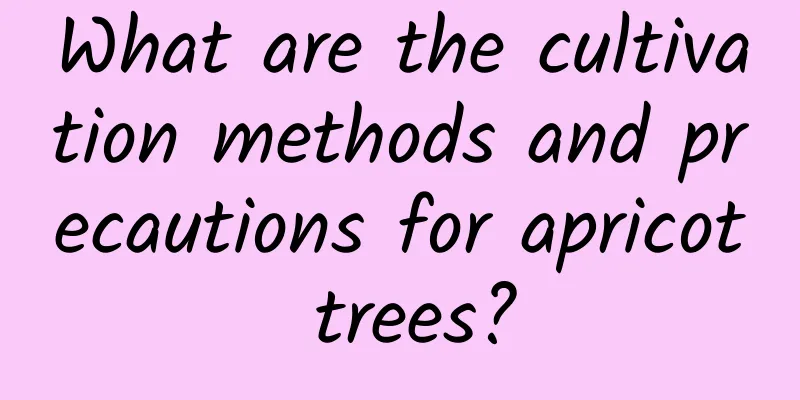What are the cultivation methods and precautions for apricot trees?

Apricot tree cultivation methodThe apricot tree belongs to the Rosaceae family. It is 5-8 meters tall and has white or red petals. Common varieties include Beijing Crystal Apricot, Hebei Large Fragrant White Apricot, Red Plum Apricot, and Large Flat Apricot. Propagation methods include sowing and grafting. Apricot trees are mainly planted in low mountains and hilly areas. They are a common fruit tree with strong adaptability and deep roots. They prefer sunny environments, are relatively drought- and cold-resistant, and have a lifespan of over a hundred years. illuminationApricot trees can receive light for a long time, but they need to be shaded in summer. Do not place them in a lightless environment for a long time, otherwise their growth will be affected, the plant will grow too long, and its normal growth and fruiting will be affected. temperatureApricot trees are relatively resistant to high temperatures. It is important to maintain a relatively high temperature during their growth period, otherwise they will suffer frostbite and will not be able to grow normally. soilApricot trees can grow on ordinary soil, and can even grow on some high-altitude or relatively poor land. Usually, the most suitable soil for it is relatively fertile and breathable soil, and it is best to ensure drainage performance. WateringAfter the apricot tree is planted, it needs to be watered thoroughly, that is, the rooting water. After that, the amount and time of watering should be determined according to the specific situation. Water frequently in hot weather and less frequently in cold weather. FertilizationWhen the new shoots of the apricot tree grow to about 15 cm, you can start fertilizing, mainly using accelerated-release fertilizers. The concentration should not be too high. Organic fertilizers and compound fertilizers can be applied in September and October. pruneIn May and June, you can leave 7-12 strong and beautiful shoots on the apricot tree, and remove the rest. When the new shoots reach 40 cm in length, you can choose 2-4 shoots for key cultivation and pruning, and remove too many and dense branches to improve the ornamental value. Apricot tree cultivation precautionsDuring the fruit-bearing period of apricot trees, they are easily harmed by pests and diseases such as almond bees and apricot weevils, which affect the quality of the fruit and may even cause the apricot trees to wither and die. Usually, the surrounding weeds need to be dealt with during the fruit-bearing period. If pests and diseases are found, the diseased fruits and branches can be manually handled, and then sprayed with pyrethroids, cypermethrin and other pesticides for prevention and control. |
<<: Can the water containing carbendazim be used to water succulent plants?
>>: What are the breeding methods and precautions of Dafugui?
Recommend
Breathtakingly beautiful masterpieces of flower arrangement and painting
Appreciation of flower arrangement paintings ...
How to raise succulent cow
1. Growth habits Before cultivating, we must firs...
What to do if the leaves of Amaryllis are too long
Summer pruning Do not cut the leaves of Amaryllis...
How to eat cinnamon, the role of cinnamon
1. How to eat 1. Cooking porridge: It can be used...
The leaves of the spider plant are yellow and the tips are dry? Water these two kinds of water, and the leaves of the spider plant will be green in 15 days
Chlorophytum has an irreplaceable position in peo...
How to choose avocados? How much does avocado cost per pound?
1. Selection method 1. Observe the skin: If you w...
How to make the lucky tree sprout new buds
1. Loosen the soil and turn the pot If the permea...
When to plant grapes
1. Planting time You must choose the right time t...
When is the best time to repot the tiger tail orchid?
Time to repot Sansevieria As the Tiger Tail Orchi...
What is Sea Holly?
1. Plants Sea holly is a biennial or perennial he...
A 70-year-old man built a sky garden next to the imperial city, the coolest in Beijing!
Near Beijing East Second Ring Road, Next to it is...
How to grow chives
Chives are known as the "lazy man's vege...
What to do if the leaves of Dutch iron turn yellow
1. Temperature reasons In fact, this is a very ea...
Can marigolds be placed in the bedroom?
1. Marigolds are not poisonous When marigold bloo...
How to prune kumquat trees
When to prune kumquat trees It is generally more ...









